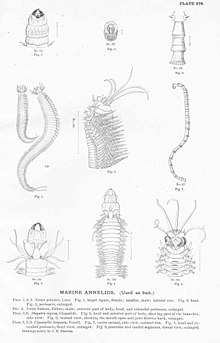Diopatra cuprea
| Diopatra cuprea | |
|---|---|

| |
| Preserved specimen | |
| Scientific classification | |
| Domain: | Eukaryota |
| Kingdom: | Animalia |
| Phylum: | Annelida |
| Clade: | Pleistoannelida |
| Subclass: | Errantia |
| Order: | Eunicida |
| Family: | Onuphidae |
| Genus: | Diopatra |
| Species: | D. cuprea
|
| Binomial name | |
| Diopatra cuprea | |
| Synonyms[2] | |
| |
Diopatra cuprea, commonly known as the plumed worm, decorator worm or sometimes ornate worm, is a species of polychaete worm in the family Onuphidae, first described by the French entomologist Louis Augustin Guillaume Bosc in 1802. It is native to the northwestern Atlantic Ocean, the Caribbean Sea and the Gulf of Mexico.[2]
Description
Diopatra cuprea inhabits a parchment-like tube made of a mucous polysaccharide material, the tip of which projects from the sediment in which the rest of the tube is buried. The tube acts as a chimney; the lower part may be a metre long and is smooth with grains of sediment adhering to it. The upper part resembles an inverted "J", with the outer surface being reinforced with shell fragments and tiny pebbles which are cemented in the style of an overlapping mosaic.[3] This part is extended by the worm if siltation threatens to bury it, and the tube occasionally has two entrances.[4]
When these tubes are no longer occupied, they get washed out of the seabed and sometimes get deposited on the strand-line. The living worm is very colourful; its reddish-brown segmented body is iridescent, and often dotted with grey. Each segment bears a pair of yellowish-brown, oar-like parapodia with green speckles, which contrast with the bright red gills[5] or "plumes" which endow the worm with its more common name, resembling a Christmas tree in rare cases. The occipital tentacles are covered with neat longitudinal rows of papillae of different sizes.[6]
Distribution
Diopatra cuprea occurs in the warm waters of the western Atlantic Ocean. Its range extends from Cape Cod southwards to the West Indies, the Caribbean Sea, the Gulf of Mexico, Trinidad and Tobago, Venezuela and Brazil.[2]
Ecology

Diopatra cuprea is an omnivore and scavenger; it feeds on algae as well as on small invertebrates such as
It can often be found in
References
- ^ Bosc, L.A.G. (1802). Histoire naturelle des vers contenant leur description et leurs moeurs. Vol. 1. Paris: Deterville. pp. 142–143.
- ^ a b c Fauchald, Kristian (2017). Read G, Fauchald K (eds.). "Diopatra cuprea (Bosc, 1802)". World Polychaeta database. World Register of Marine Species. Retrieved 19 July 2017.
- ISBN 978-1-135-07607-8.
- .
- ^ ISBN 978-1-58979-061-2.
- ^ The Royal Society of New Zealand. Journal of the Royal Society of New Zealand. The Royal Society of New Zealand. p. 283.
- PMID 36290391.
- ISBN 978-0-643-06571-0.
